
Original Link: https://www.anandtech.com/show/2141
Rainbow Six: Vegas: A Performance Analysis
by Josh Venning on December 25, 2006 6:00 AM EST- Posted in
- Gaming
Introduction
We recently looked at performance with Ubisoft's Splinter Cell: Double Agent and saw that although the game has some enjoyable gameplay elements, there were some technical problems at its release that couldn't be overlooked. When a consumer brings home a game for their PC that they've paid for with their hard-earned money, they should be able to enjoy that game without having to deal with things like crashing and incompatibility issues. Granted, it's not as easy to buy, setup and play a game for the PC as it is for a console system, and some would cite this as an incentive to go with a console gaming system instead of a PC. We feel however, that PCs have just as much if not more potential than consoles for providing incredible gaming experiences.
Of course, there is still the issue of hardware, and the fact is that good hardware is required to enjoy the best PC gaming has to offer. We've talked about Splinter Cell: Double agent, and today we are looking at another game by Ubisoft; the newly released Rainbow Six: Vegas (RSV). We'll be talking a little about the game and how it performs, and we're especially interested in it because it's one of the first games out now based on Unreal Engine 3.
Thankfully with Rainbow Six: Vegas, we found we didn't run into nearly as many of the problems and annoyances we did with Double Agent, and for the most part the game seems like a much more solid port of the Xbox 360 version, if this is in fact the case. It isn't perfect, however, and there are some issues that still should have been fixed before the game's release, but we'll talk about these later on.
Testing performance with Rainbow Six: Vegas was a little more straightforward than we saw with Splinter Cell: Double Agent, but we've tested the game on the same range of cards and we now have a good idea of the type of performance you can expect for this game. While it does break ground somewhat on the graphics engine front (being based on the Unreal Engine 3), it doesn't really do the same for GPU performance requirements (as with Oblivion), which is good news for those looking to buy Rainbow Six: Vegas. However, it can still tax most GPUs out there at higher resolutions and quality settings, and you will most likely need at least a mainstream graphics solution to enjoy the game. We'll give you the details on all this in the performance section.
Overall we were impressed with what we've seen in this latest addition to the Rainbow Six series, and we're sure many fans - as well as those not so familiar with the Rainbow Six series - will enjoy it. The overall graphical quality of the game is excellent, and puts games based on the older Unreal Engine 2 (like Splinter Cell: Double Agent) to shame. We enjoyed playing and testing Rainbow Six: Vegas, so without further ado, let's take a look at the game and our benchmark.
Graphics Settings
Rainbow Six: Vegas as we mentioned came with a lot fewer bugs and less clunkiness in the interface than the previous Splinter Cell: Double Agent we reviewed. We didn't experience any of the crashing problems with certain hardware when changing settings and we didn't have to restart the game constantly to get some settings to change. Also, loading and exiting a game to the menu took much less time which made our testing much easier - something we were very thankful for after our negative experience with the Double Agent interface.
The graphics quality settings for Vegas are a lot more straightforward than with Double Agent as well, while still offering control over a few basic settings. Some gamers might have liked more control over specific graphics options, but unfortunately they are out of luck. Still, some control is better than none, and here are the options we have available.
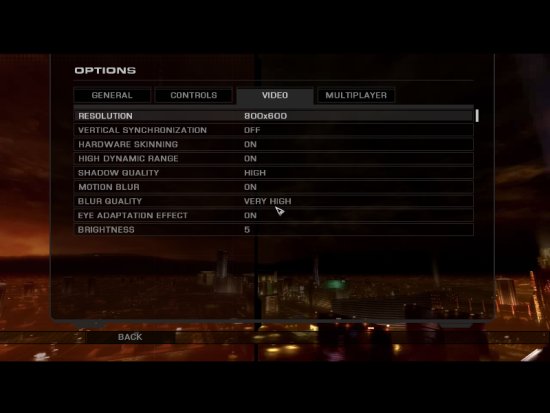
- Hardware Skinning: on/off
- High Dynamic Range: on/off
- Shadow Quality: very low/high
- Motion Blur: on/off
- Blur Quality: very low/very high
- Eye Adaptation Effect: on/off
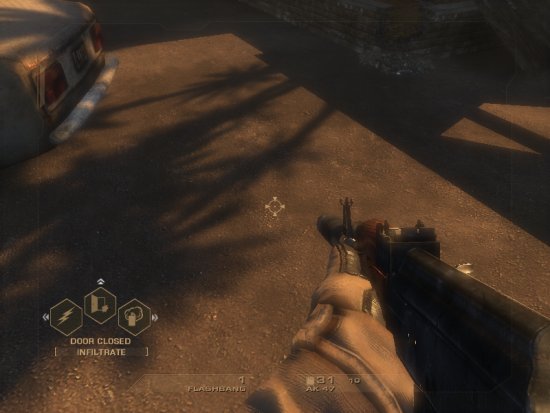
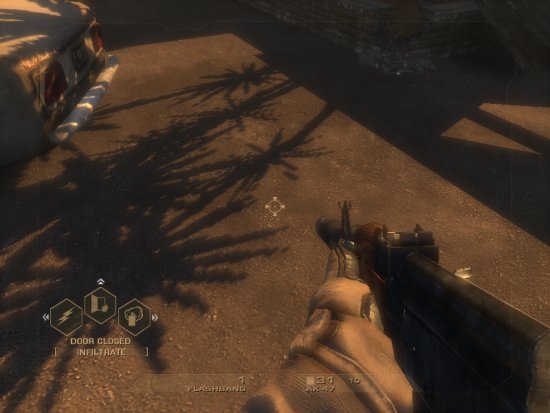
As with Double Agent, we tested Rainbow Six: Vegas at two different quality settings: one with the graphics settings at their highest, and one at lower quality settings for the lower-end cards. We only tested lower-end and midrange cards at the low quality settings, as they were the only ones that could really benefit from the extra performance. Also, the highest resolution available in the game menu is 1600x1200, but even for those with displays capable of higher resolutions, running Vegas smoothly at this resolution with the settings on highest quality will need a powerful graphics solution - something more along the lines of an 8800 rather than a 7900 GTX or X1950 XTX.
When testing at the highest quality settings, each setting was turned "on" or to the highest option available. Conversely, with the lower quality settings, we turned everything to "off" or to their lowest setting, with the exception of hardware skinning. We found this setting didn't cause much of a performance hit on our benchmark when enabled, so we left it on for all the tests. (Note that this might not be the case in other parts of the game where there are lots of characters in the scene, and turning hardware skinning off is suggested to improve gameplay performance if necessary.)
We found that with Rainbow Six: Vegas, there wasn't as much of a performance gain as we would have liked with all of the quality settings at their lowest, but we also didn't notice much difference with the settings all off, aside from the most obvious shadow effects. The game is still enjoyable with the lower quality settings, and even at a resolution of 800x600 it still looks good. The lack of an in-game option for selecting widescreen resolutions is unfortunate, but luckily some enterprising souls have created a hack available at the WSGF for the interested.
The Benchmark
Our benchmark was suggested to us by Ubisoft and it's basically an average FPS of looking out of the window on the first helicopter ride over a cityscape in Mexico. The game has no quicksave or save options, only a checkpoint system that lets you load a checkpoint as you progress in the game. There was no timedemo function to record a demo so we used FRAPS to benchmark the game. This is unfortunate because it means we can't test how the game performs during firefights, which are more graphically intensive than the helicopter ride. We can get a general idea of overall game performance, however, taking into account our benchmark results.
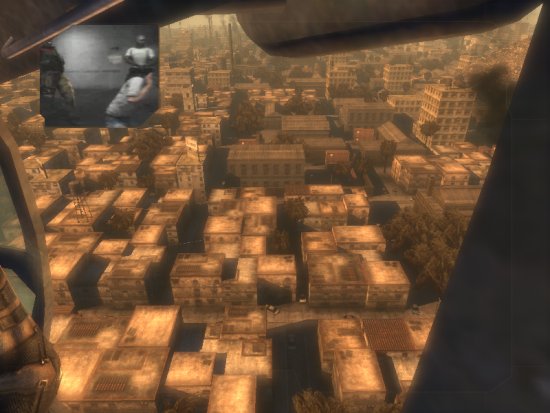
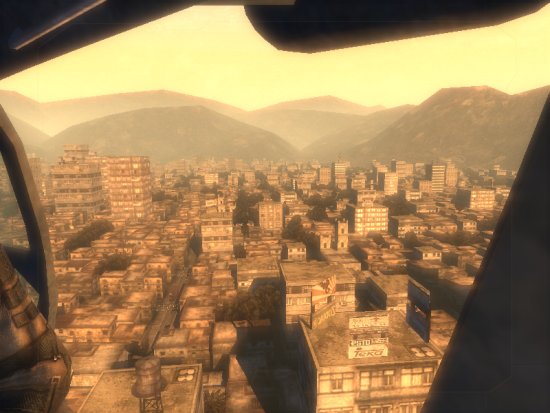
The cityscape in this first helicopter ride is impressive, with individual buildings stretching far to the horizon and large mountains looming over them in the distance. Smoke billows out of smokestacks, and some skyscrapers jut out higher than the others, while the helicopter's shadow is cast realistically further and closer on the buildings as you approach the drop-off point.
Because there aren't really any characters in the scene we used for our benchmark, the frame rate we will see in our tests will be a little higher than what we would expect during much of the gameplay of RSV. You can expect performance to decrease by as much as 30% or more with multiple enemies and your teammates all fighting in a scene. This makes things difficult as the action in the game can be very fast paced, and finding a target and hitting him accurately and quickly is sometimes vital to your survival.
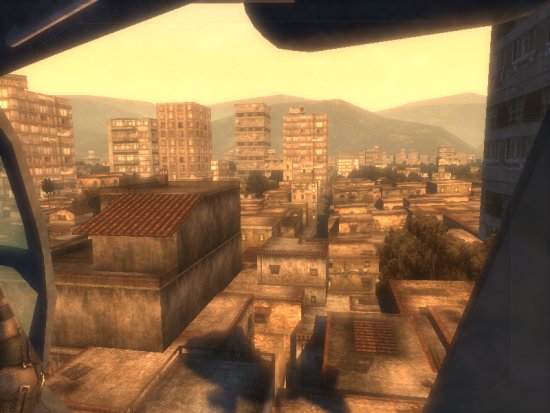
Setting Expectations
As we mentioned, Rainbow Six: Vegas is one of the first games out that incorporates the Unreal Engine 3, which makes it somewhat special. Another game out which uses the Unreal Engine 3 is Gears of War for the Xbox 360, which we hope to see released for the PC sometime soon. We can hope that Rainbow Six: Vegas performance will reflect future games based on the Unreal Engine 3, because compared to games like The Elder Scrolls IV: Oblivion when it was first released, the biggest and best GPU available isn't really required to enjoy this game right now. To be fair, it's worth nothing that the performance requirements are about as strenuous as Oblivion, if not slightly higher; the only difference is that the new GeForce 8800 series is now available.
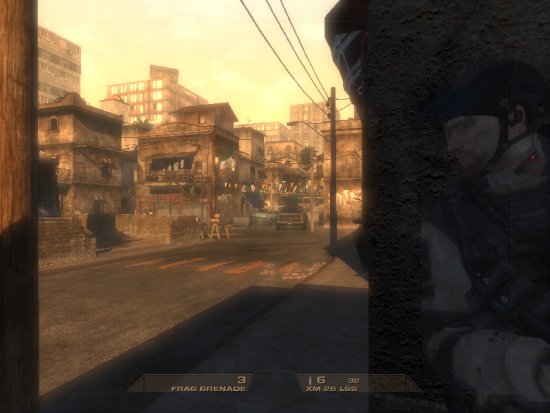
The Unreal Engine 2 made use of DX8, but DX9 elements (things like HDR and shadow effects) were added in more recent games like Splinter Cell: Double Agent. The Unreal Engine 3 is more based on the programmable graphics aspect of DX9, and future titles using UE3 should also support DX10/WGF2. This basically means developers have more flexibility when making a game for this engine. A lot of game developers licensed the UE2, and we are expecting the same with the UE3. At any rate, the next big game expected using the Unreal Engine 3 is in fact Unreal Tournament 2007, which will hopefully be available soon.
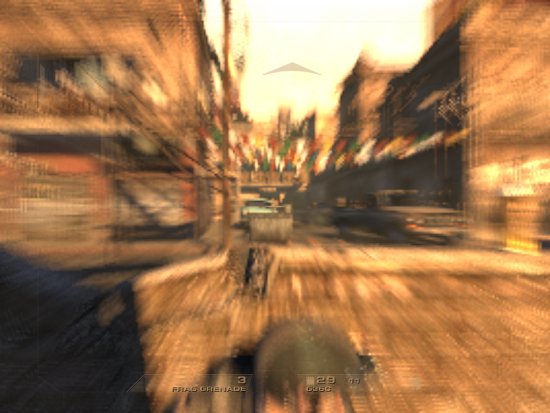
We mentioned in the introduction that the game had a few issues we wish would have been addressed before Rainbow Six: Vegas was released. One of them is that as of right now, there doesn't seem to be any support for SLI or Crossfire setups. This is bad news because Vegas is one game that could use the type of flexibility a multi-GPU system could provide. Another issue that could be seen as a drawback is the lack of antialiasing in the game. There is no option for turning on AA and we aren't extremely surprised about this given that the game uses the very new Unreal Engine 3. Hopefully we will see support for this in the future though, as the fastest GPUs should be able to handle HDR as well as FSAA.
Test Setup
As with our last game article, we grouped the performance tests into three different categories: low-end, mainstream/midrange, and high-end graphics performance. However, we only have one benchmark for Rainbow Six: Vegas, which will mean fewer numbers. In two of the three sections, the low-end and mainstream/midrange, we have performance results for the game at both highest and lowest quality settings. We chose the same types of cards from ATI and NVIDIA for testing this game as with Double Agent, and we used these solutions because they cover a broad spectrum of current-generation cards at different performance levels.
The NVIDIA cards we tested Vegas with are the 7300 GT, 7600 GS, 7600 GT, 7900 GS, 7950 GT, 7900 GTX, and the 8800 GTS and GTX. From ATI, we have the X1300 XT, X1650 Pro, X1650 XT, X1900 XT 256, and X1950 XTX. We are happy to report that unlike with Double Agent, Rainbow Six: Vegas runs on the 8800 without any strange graphical artifacts at all. Also, because the game doesn't yet officially support SLI, the 7950 GX2 doesn't see the type of performance in this game that it should, and so it was omitted from our tests. We would have very much liked to have seen how quad SLI handled the game, but unfortunately we will have to wait and hope a patch or driver update will allow this. The 7300 GS performed so poorly with this game that it wasn't included in our tests, and needless to say we don't recommend trying to play Rainbow Six: Vegas on this card. In fact, any current card that costs under $125 is going to have difficulties unless you run at lowest quality settings and a low resolution.
Here is the system we used for our performance tests.
| System Test Configuration | |
| CPU: | Intel Core 2 Extreme X6800 (2.93GHz/4MB) |
| Motherboard: | EVGA nForce 680i SLI Intel BadAxe |
| Chipset: | NVIDIA nForce 680i SLI Intel 975X |
| Chipset Drivers: | Intel 7.2.2.1007 (Intel) NVIDIA nForce 9.35 |
| Hard Disk: | Seagate 7200.7 160GB SATA |
| Memory: | Corsair XMS2 DDR2-800 4-4-4-12 (1GB x 2) |
| Video Card: | Various |
| Video Drivers: | ATI Catalyst 6.10 NVIDIA ForceWare 96.97 NVIDIA ForceWare 91.47 (G70 SLI) |
| Desktop Resolution: | 2560 x 1600 - 32-bit @ 60Hz |
| OS: | Windows XP Professional SP2 |
High-End Performance
As we saw with other games like Oblivion and Double Agent, Rainbow Six: Vegas performs better on ATI cards than NVIDIA ones at the same price point. This is something that can possibly change as drivers are updated and game patches are released in the future. Something to keep in mind is in our benchmark for Vegas, average FPS of a little over 20 will mean relatively smooth frame rates throughout most of the game. There will however be times when action gets heated and you will experience choppiness on cards that score less than ~30 FPS in our particular benchmark scenario.
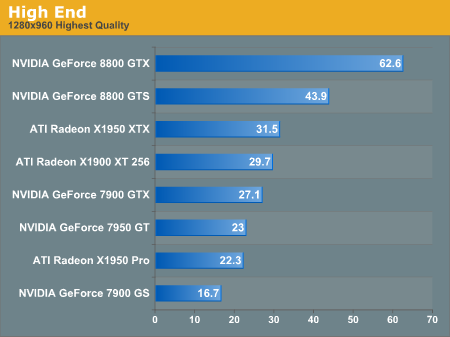
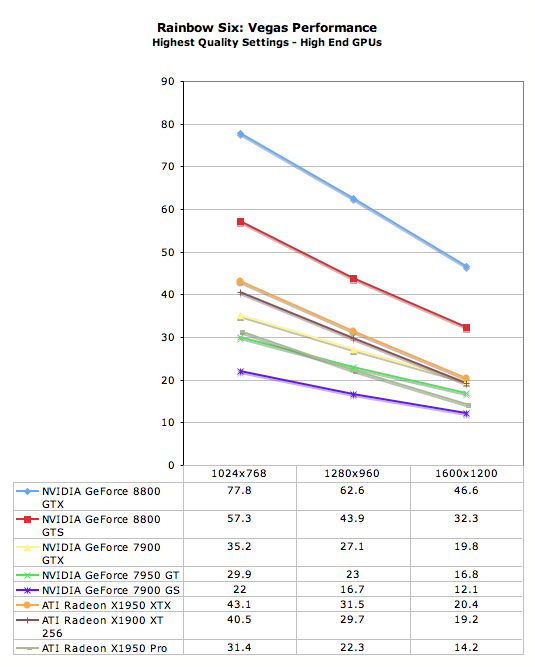
We can easily see from these results how much performance NVIDIA's 8800 series of cards are capable of over the rest of the competition. ATI doesn't actually have any direct competition to the 8800 right now, so those wanting the fastest performance in this or basically any other game will have to go with NVIDIA. (Don't plan on running the beta/release candidate of Vista on 8800 cards right now, however, as the Vista drivers are still not finalized.) This shows how, as we said earlier, the 8800 GTS and GTX are the only two cards that can really run the game smoothly at the highest resolution with the highest quality settings enabled.
The X1950 XTX almost runs the game smoothly at the highest settings, and with some overclocking, Vegas has a good chance of running perfectly fine at maximum details and 1600x1200 with this card. Similarly, the 7900 GTX, as powerful as it is, just can't manage acceptable performance in the game at 1600x1200 at reference speeds, but at one resolution down it looks and plays fine.
Mainstream/Midrange Performance
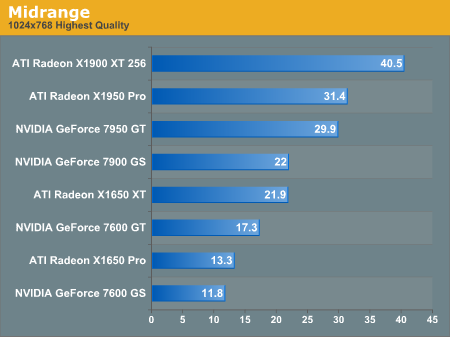

Rainbow Six: Vegas is a graphically intensive game, but as we said, we didn't have to play it at the highest resolution for it to look good. 1024x768 isn't a bad compromise to get a good balance of performance and graphics out of the game. When we step down to the midrange cards, this is really the most that any of these cards can handle at the higher detail settings. The X1650 XT is your best choice for playing this game at 1024x768 at the highest settings, but some overclocking might still be necessary. The slightly higher price of the X1650 XT (if you can find it right now) would still be a better choice for this game than the 7600 GT - its direct competitor from NVIDIA - because of the extra performance we see here.
Now let's look at how these cards perform with the same benchmark at the lower quality settings.


We can see that with NVIDIA, the amount of performance gain we generally see from turning the graphics quality settings down varies from around 40% to 45%. With ATI however, the performance gains are around 55% to 60%. This means obviously we'll have a better chance of picking up more performance and playing the game at a higher resolution with ATI cards by turning the quality settings down.
Low-End Performance

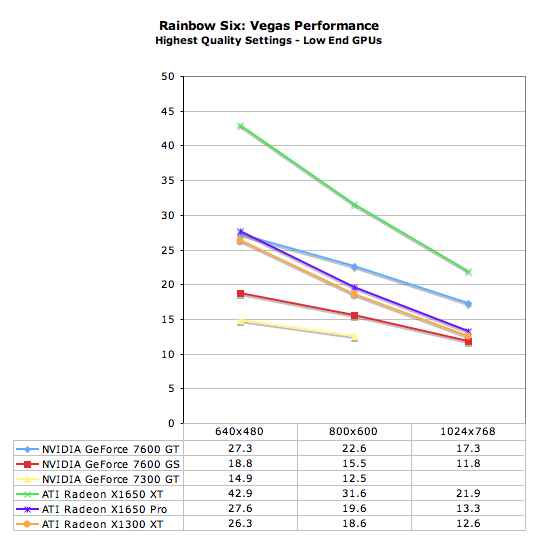
At 640x480, Rainbow Six: Vegas is technically playable, but a lot is lost graphically and we would recommend at least a resolution of 800x600 to really enjoy the game. At highest quality settings however, you won't have much luck playing Vegas on a low end card at any resolution, with perhaps the exception of the X1300 XT (which is simply a renamed X1600 Pro).

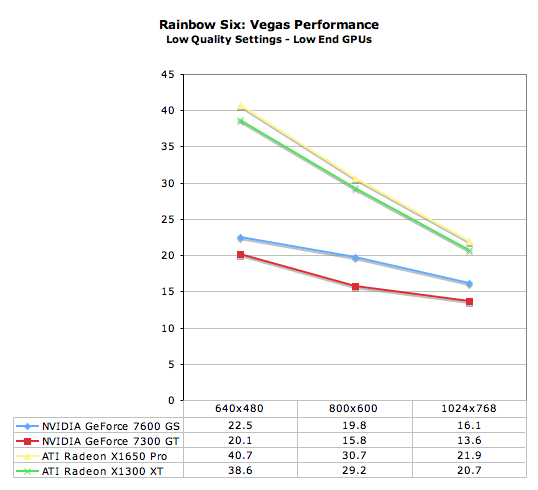
Turning the quality settings down boosts performance a bit for these cards, but we can see how the amount of performance gain we see doesn't provide a lot of flexibility for these cards, particularly with NVIDIA hardware. It's very evident looking at all of these tests how Rainbow Six: Vegas tends to favor ATI hardware, but again, keep in mind that because of patches and updates this may not (and hopefully won't) be the case for long.
Final Words
Rainbow Six: Vegas has all the elements of a great tactical shooter, with great graphics and very realistic AI. Your teammates are very handy and can take care of themselves, doing what you tell them while taking cover and engaging hostiles at their own discretion. As with any game AI they aren't perfect and sometimes they die for very stupid reasons, but mostly they are incredibly useful in clearing rooms and getting your missions accomplished. Similarly, the enemy AI is deadly at the "realistic" difficulty setting, and they will actively seek you out and try to flank your team while taking cover and using grenades or flashbangs. Clearing a room full of tangos requires the use of sound tactics, such as suppressing your enemy and sending a team or yourself to flank them while they hide behind cover. This element of realism that we've seen in games like Brothers in Arms is a nice touch and makes the game a lot more fun.
Gameplay aside, the game shows off the new Unreal Engine 3 nicely, and there are a lot of excellent graphical elements to the game. The smoke effect is good when you or an enemy pops a smoke grenade for cover, and the way explosions and gunfire interact with the environment causing damage to things like slot machines and glasses at adds a nice element of chaos to the action. As we've seen though, these graphical elements come at a high price, and Rainbow Six: Vegas is by no means a game for those with a low-end graphics solution.
Our performance tests show that in order to play this game smoothly with the resolution and quality settings at their highest, you will need at least an NVIDIA 8800 GTS (or possibly an overclocked X1950 XTX). The X1950 XTX and 7900 GTX at reference speeds can run the game at these settings without too much trouble, but they still see some choppiness when in a large firefight with a lot of stuff going on. Fortunately, the game still looks and plays well with the resolution and quality settings turned down, so don't despair if you aren't an owner of an 8800 yet and want to get a hold of this game. We still don't recommend playing Rainbow Six: Vegas on a low end card like the 7300 GT, because even at the lowest resolution and settings you will still probably run into choppy gameplay at certain points in the game, and the action can be fast-paced enough that this is a real problem. At this point in time, to really enjoy this game at a decent resolution you will probably want to go with at least a 7600 GT from NVIDIA or better yet an X1650 XT from ATI if you can get your hands on one. GeForce 7900 GS and Radeon X1900 GT are also good options.
Even though Rainbow Six: Vegas uses the Unreal Engine 3, something it shares with Epic's Gears of War for the Xbox360, its graphics don't really compare to Gears, and there are some places where the environments in Vegas could look better. One example is during the helicopter flight over Las Vegas at night. Overall though, Vegas' graphics are very impressive, and they certainly represent a significant improvement compared to other games like another Ubisoft title we may have mentioned a few times.
Hopefully we will see some improvements in performance for Vegas on NVIDIA's hardware soon, because as it stands, the game clearly favors ATI parts, with the obvious exception of the 8800. That is a trend we've seen more of over time, however: G70 series hardware does very well at DX8 graphics, but when more DX9 effects are enabled the pixel shaders on many NVIDIA chips don't seem to do as well as ATI's hardware. We might have liked to see the kind of control over graphics quality in Vegas that we've seen in games like The Elder Scrolls IV: Oblivion, especially considering that maximum detail settings result in performance that is often lower than what we saw with Oblivion. Still, kudos to Ubisoft on this nice addition to the Rainbow Six series, and we look forward to further enjoying this game, as well as seeing what else comes along using the Unreal Engine 3 in the near future.







